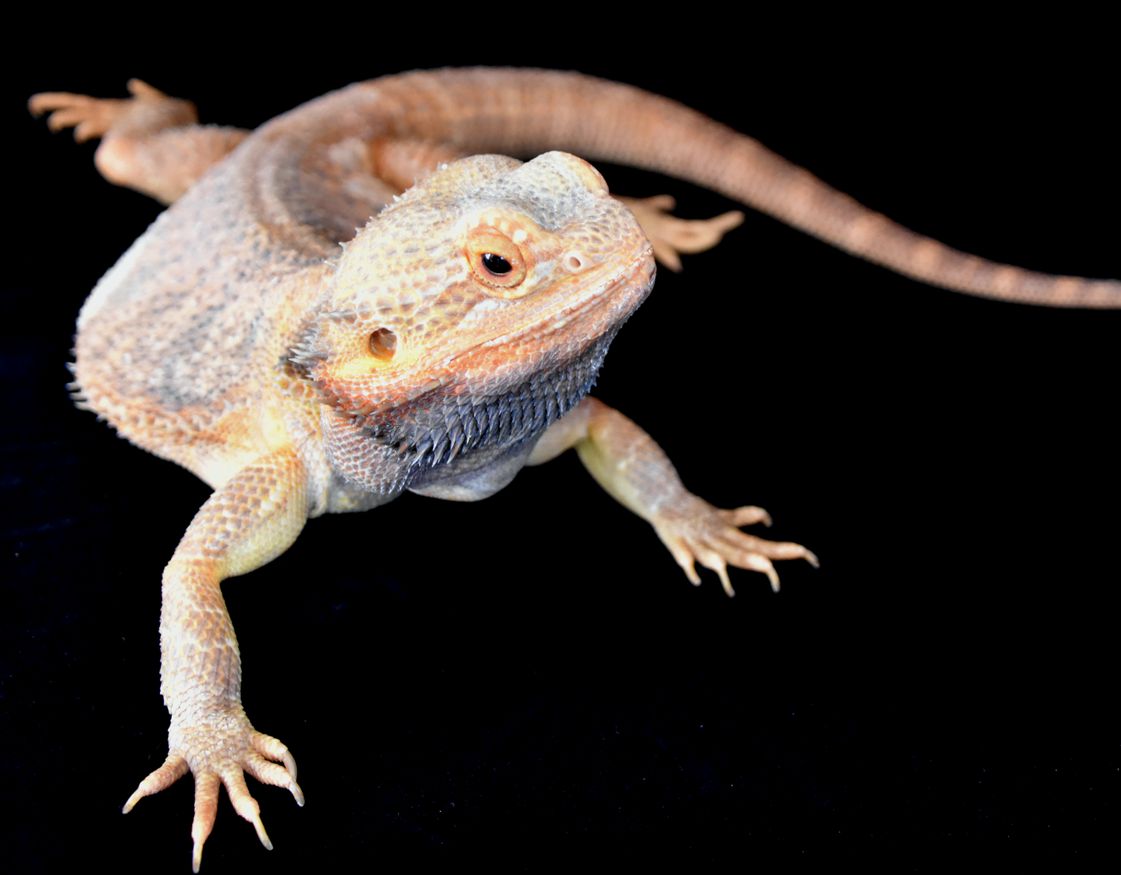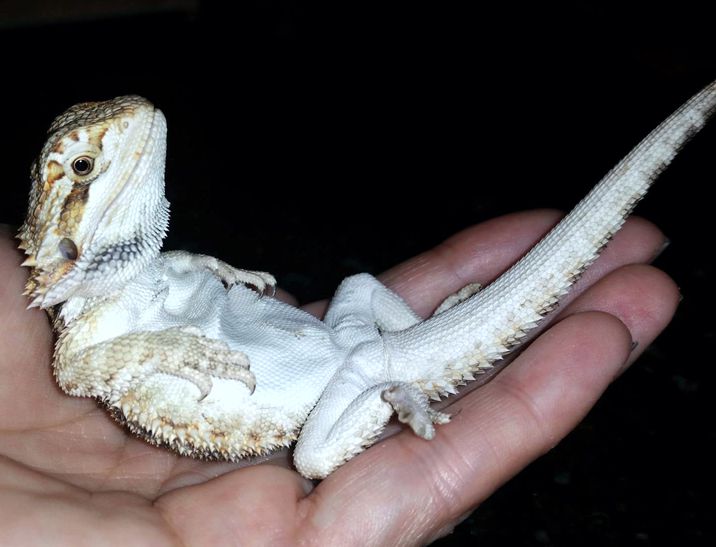Basic Care: Bearded Dragon
 Bearded dragons are social, active lizards that need proper heat, ultraviolet light, and the correct diet with necessary supplements. Bearded dragons may not get along if crowded or territorial so caution with housing them together and ideally never have an adult with baby bearded dragons.
Bearded dragons are social, active lizards that need proper heat, ultraviolet light, and the correct diet with necessary supplements. Bearded dragons may not get along if crowded or territorial so caution with housing them together and ideally never have an adult with baby bearded dragons.
Caging
An adult bearded dragon needs a cage at least 3 ft long, 2 ft wide, and 1.5 ft tall.
Substrate
Newspaper has the least problems of any substrate. Sand and cypress mulch may be used but can causes constipation and other problems if eaten. Most bearded dragons appreciate a hide box that contains moist substrate, such as slightly damp sphagnum moss. This can double as a nest box for a breeding female.
Heat and Light
A basking light, typically a 60-100 watt spotlight, should be set-up on one end of the tank. The temperature underneath the spotlight should reach 98-105°F. The cooler end of the cage should be about 10-15°F cooler. Use an infrared (laser) thermometer to directly measure the temperature of your lizard. If it spends all its time under the light, the cage may be too cool. If it spends all its time at the cool end of the cage, the basking spot may be too hot. Some source of floor heat, such as a heat tape, is useful for night time heat. Smaller bearded dragons that like to perch on branches overnight may need a red basking light or ceramic heater to keep them warm overnight when the white basking light is off. Ultraviolet-B light is essential for bearded dragon health. There are many different brands of bulbs that claim to produce UV-B but only a few companies have a proven track record and published data on their bulbs. We recommend ZooMed’s Reptisun 5.0 UV Bulb or 10.0 UV Bulb and Power Sun as excellent sources of UV-B. A UV-B light should be set up to illuminate the area around the basking light. The Power Sun may serve as the basking light. All UV-B bulbs need to be replaced every 6-12 months, even if they are still shining, because their ultraviolet-B output decreases over time.
For more information in UVB lighting please visit /reptiles-amphibians-lizards-salamanders-snakes-tortoises-turtles/ultraviolet-lighting-reptiles
Diet
Crickets and king mealworms dusted with mineral and vitamin supplements should be offered two to three times a week to adult bearded dragons. Phoenix worms are a high calcium food source that many bearded dragons eat readily. Caution with overfeeding Dubia roaches or making them the main insect as this is not advised.
Younger bearded dragons may need to eat every day. The size of food offered should be no longer than the gap between a bearded dragon’s eyes.
Recommended nutritional dusts are Zoomed's Calcium Dust with Vitamin D3 and either Zoomed's Reptivite or Nekton-Rep, or Repashy products. Pinkies should be fed sparingly.
A mixed salad should be offered three times weekly. One recipe for bearded dragon salad is:
Produce: 1 cup romaine lettuce or escarole; ¼ cup of collard greens, mustard greens, dandelion greens, and/or kale; ¼ cup shredded carrots, green beans, squash; 1 tbsp chopped fruit; 1/8 teaspoon Reptical with Vitamin D3; 1/8 teaspoon Nekton-Rep
Small amounts of dark green leafy vegetables, fresh grass, mulberry leaves, and hibiscus leaves and flowers may also be given.
Water
Fresh water should always be available. Disinfect the bowl with a solution of 1 tablespoon bleach to 1 cup of water at least once a week and rinse thoroughly with fresh water before refilling it for your bearded dragon. Many bearded dragons like to drink from the light stream of a handheld garden sprayer and should be spray-misted several times a week.
Bearded dragons seem to need a lot more water than one would expect for lizards that evolved in a dry habitat--however, they spend a lot of their time in humid areas beneath plants or in burrows so they actually get quite a bit of water this way. A soaking in warm water once to three times a week is suggested to make sure that your bearded dragon is drinking enough. Many bearded dragons develop a problem with constipation if they do not get enough water or enough salad in their diet.
Handling Tips
 Bearded dragons under 8 inches long may be skittish and will not like being handled. Larger bearded dragons quickly learn to enjoy being held and petted. Children under the age of ten should always have an older experienced bearded dragon handler help them hold the lizard.
Bearded dragons under 8 inches long may be skittish and will not like being handled. Larger bearded dragons quickly learn to enjoy being held and petted. Children under the age of ten should always have an older experienced bearded dragon handler help them hold the lizard.
Due to the risk of salmonellosis, always wash hands thoroughly with warm water and soap after handling your bearded dragon. All reptile owners should learn about preventing this disease by reading the website http://www.arav.org/SalmonellaOwner.htm or reading our webpage, Salmonella Hygiene.
Preventive Medicine
A fecal parasite examination every 6 months is recommended to detect parasites that can impact your bearded dragon’s health. If you don’t plan to breed your female bearded dragon, it should be spayed to avoid problems such as retained eggs. An annual check-up with bloodwork is recommended to monitor your bearded dragon’s health.
Common Problems Requiring Veterinary Attention
- Not eating
- constipation (not going to the bathroom)
- diarrhea
- losing weight
- swollen belly
- trembling
- limping
- reluctance to move
- bulging eyes
Some of the common diseases are nutritional secondary hyperparathyroidism (also known as metabolic bone disease and calcium deficiency), gout, renal failure, coccidiosis, flagellates, pinworms, atadenovirus, constipation, and dystocia.
The Bearded Dragon Manual (© 2001 by Philippe de Vosjoli, Robert Mailloux, Susan Donoghue, Roger Klingenberg, and Jerry Cole) is a great book on bearded dragon care.



